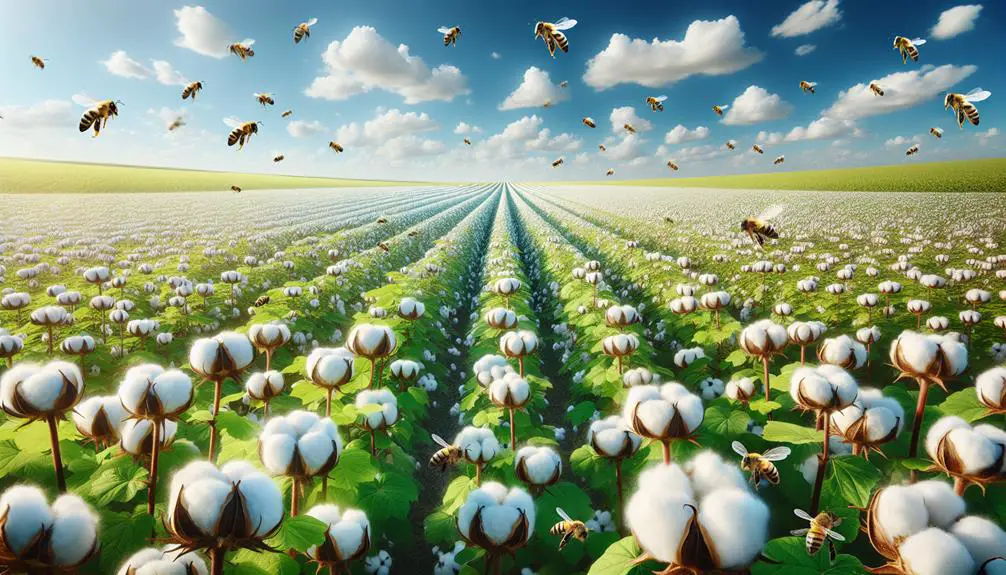Sustainable cotton brings many perks like less water use, no harmful chemicals, backing biodiversity, locking carbon, and shielding water sources. It's a green choice with huge benefits for nature and us.
Table of Contents
Key Takeaways
- Reduced water usage and pollution in sustainable cotton production.
- Elimination of harmful pesticides for environmental and worker health.
- Promotion of biodiversity and healthier soil through organic farming methods.
- Lower greenhouse gas emissions and energy efficiency in cultivation.
- Fair wages, safer working conditions, and ethical practices for cotton workers.
Environmental Benefits of Sustainable Cotton
Choosing sustainable cotton production has numerous environmental benefits that positively impact our planet. By opting for organic cotton farming methods, we can greatly reduce water usage through the promotion of efficient irrigation techniques. Unlike conventional cotton farming, organic practices eliminate harmful chemicals, pesticides, and synthetic fertilizers, safeguarding both the environment and our health.
Moreover, sustainable cotton cultivation plays an essential role in supporting biodiversity. By reducing soil erosion and preserving natural habitats, eco-friendly cotton production fosters a healthier ecosystem for various plant and animal species. Additionally, promoting carbon sequestration in the soil through sustainable practices aids in mitigating climate change.
Not only does choosing sustainable cotton benefit the environment directly, but it also helps protect water sources from pollution and contamination. By making conscious decisions in favor of sustainable cotton, we contribute to a cleaner, healthier planet for current and future generations.
Social Advantages of Eco-Friendly Cotton
Moving from the environmental benefits of sustainable cotton, let's now explore the positive social impacts of eco-friendly cotton cultivation. Eco-friendly cotton farming not only eliminates the need for harmful pesticides but also promotes safer working conditions for cotton farmers. By adopting crop diversity methods, farmers can secure a healthy livelihood while supporting local economies. Organic cotton serves as an affordable option that doesn't require special processing, benefiting both producers and consumers. Purchasing products made from eco-friendly cotton not only helps in sustainable practices but also supports local communities by boosting their economies.
One of the key social advantages of eco-friendly cotton is the fair treatment of workers. By following ethical and sustainable practices, such as ensuring fair wages and safe working conditions, the cotton industry can uplift the lives of many workers involved in the production process. This commitment to fair treatment not only benefits the workers directly but also contributes to the overall sustainability and positive impact of eco-friendly cotton cultivation.
Economic Sustainability of Cotton Production
Let's talk about how cotton production can be economically sustainable.
We'll touch on how cost-effective farming methods, the creation of job opportunities, and the impact on market stability all play an important role in this aspect.
Cost-Effective Cotton Farming
Shifting to sustainable cotton farming practices not only benefits the environment but also proves to be a smart financial choice for farmers seeking long-term cost savings. By adopting eco-friendly methods like organic cotton farming, farmers can reduce costs by eliminating the need for expensive chemical pesticides and fertilizers.
Embracing sustainable practices not only leads to immediate savings but also sets the stage for long-term economic stability. Organic farming techniques not only help in avoiding costly inputs but also promote soil health, ensuring sustainable yields for years to come.
Embracing sustainable cotton farming reduces the financial burden on farmers through natural pest control methods and decreased water consumption. Investing in sustainable practices offers economic resilience, safeguarding farmers against market fluctuations and ensuring a profitable future.
Job Creation Opportunities
Cotton production offers millions of people worldwide valuable job opportunities, supporting livelihoods in rural communities and driving economic sustainability in the textile industry. The demand for cotton in the textile and apparel sector creates employment for farmers, laborers, and factory workers, contributing to economic growth.
By adopting sustainable cotton farming practices, we can guarantee stable job creation in both agriculture and textiles. These job opportunities not only benefit individuals but also support local communities by providing a reliable source of income.
Fostering job creation in cotton production is essential for enhancing economic sustainability and promoting a strong textile supply chain. Sustainable practices in cotton farming play an important role in securing jobs and bolstering the overall economy.
Market Stability Impact
Ensuring market stability in cotton production is vital for sustaining economic viability and supporting rural livelihoods globally. Cotton serves as a dependable income source for farmers worldwide, fostering economic sustainability in rural communities and stabilizing local economies.
The global cotton industry plays a pivotal role in generating substantial revenue and employment opportunities, contributing to overall economic growth. Market stability in cotton production guarantees a consistent supply of raw materials for the textile manufacturing industries.
Reduced Water Usage in Cotton Farming
Reducing water usage in cotton farming is essential for sustainability. Water-efficient farming methods and sustainable irrigation practices are key to achieving this goal.
Conserving water not only benefits the environment but also supports communities facing water scarcity.
Water-Efficient Farming Methods
Employing sustainable farming techniques in cotton cultivation greatly reduces water usage, benefiting both the environment and future generations. Water-efficient farming methods such as drip irrigation and rainwater harvesting play an essential role in minimizing water wastage in cotton farming. By implementing these practices, up to 50% less water is used compared to conventional cotton production methods.
The focus on water efficiency not only conserves water resources but also reduces the environmental impact of cotton cultivation. Precision farming and advanced soil moisture monitoring systems further enhance water efficiency in cotton farming, ensuring that water is used sparingly and effectively. These sustainable approaches contribute to the preservation of water for future generations, making cotton production more environmentally friendly and sustainable in the long run.
Sustainable Irrigation Practices
Moving from water-efficient farming methods, let's explore how sustainable irrigation practices revolutionize water usage in cotton farming.
Sustainable cotton farming implements efficient irrigation systems that reduce water usage by up to 50% compared to traditional methods. Techniques such as drip irrigation and rainwater harvesting play a vital role in minimizing water wastage and promoting water conservation in cotton cultivation.
By utilizing soil moisture sensors and precision irrigation technology, sustainable cotton production guarantees efficient water usage while enhancing crop yield. These sustainable water management practices not only benefit the environment but also contribute to the long-term sustainability of cotton farming.
Embracing these methods is key to promoting water conservation and achieving environmental sustainability in cotton cultivation.
Conservation of Water
In sustainable cotton farming, efficient irrigation practices play an important role in conserving water resources. When cotton is grown sustainably, it uses up to 90% less water compared to conventional methods. By implementing water-saving technologies such as drip irrigation and soil moisture sensors, farmers can optimize water usage for cotton cultivation. Rainwater harvesting also contributes to reducing water consumption in cotton farming.
This reduced water usage not only helps in conserving water but also addresses water scarcity issues in drought-prone regions. Sustainable cotton production promotes water stewardship, encouraging responsible water management practices throughout the textile industry. By prioritizing water conservation in cotton farming, we can make a significant impact on preserving this essential resource for future generations.
Healthier Soil From Sustainable Practices
Sustainable cotton farming practices foster healthier soil by minimizing chemical inputs and promoting biodiversity. Unlike conventional methods that rely heavily on synthetic pesticides and fertilizers, sustainable cotton cultivation, including organic cotton, prioritizes the use of natural alternatives. By steering clear of harmful chemicals, the soil's fertility and structure are preserved, ensuring long-term productivity. Implementing techniques like crop rotation and cover cropping further enhances soil health in sustainable cotton farming. These practices not only boost soil quality but also aid in erosion control, maintaining the land's integrity for future use.
Healthy soil resulting from sustainable cotton practices offers a range of benefits, such as improved water retention and better nutrient cycling. These factors contribute to the overall health of the ecosystem, creating a harmonious balance within the agricultural environment. Emphasizing soil conservation in sustainable cotton farming not only supports the current crop but also lays the groundwork for future generations, promoting both agricultural viability and environmental sustainability.
Worker Safety in Sustainable Cotton Production
Ensuring the safety of workers in sustainable cotton production involves implementing practices that prioritize their well-being and health. When it comes to worker safety, sustainable cotton production shines by reducing exposure to harmful pesticides, promoting fair trade practices, and upholding ethical labor standards.
Let's take a closer look at how sustainable cotton production benefits worker safety:
| Worker Safety Benefits | Description |
|---|---|
| Reduced Exposure to Harmful Pesticides | Organic cotton farming minimizes the use of toxic chemicals, protecting workers from health risks. |
| Fair Trade Practices | Ensuring fair wages, safe working conditions, and worker rights support the well-being of those involved in cotton production. |
| Ethical Labor Practices | Prioritizing worker safety and health through responsible labor standards fosters a sustainable work environment. |
| Health Risks Mitigation | Eliminating toxic chemicals in cotton cultivation not only benefits the environment but also safeguards workers' health. |
In sustainable cotton production, worker safety is not just a priority; it's a fundamental principle that drives ethical and responsible practices.
Energy Efficiency in Cotton Cultivation
Boosting energy efficiency in cotton cultivation involves implementing sustainable practices that reduce environmental impact and resource consumption to a significant extent. Compared to traditional cotton production methods, sustainable cotton cultivation uses 62% less energy, making a significant difference in lowering the carbon footprint.
Opting for organic cotton, which releases 46% less CO2 into the environment, further enhances energy efficiency. By minimizing energy-intensive processes like pesticide use and irrigation, sustainable cotton farming not only conserves resources but also reduces CO2 emissions.
Traditional cotton production is known for its high energy consumption and significant contribution to CO2 emissions, highlighting the importance of shifting towards more sustainable practices. Choosing organic cotton textiles not only benefits the environment but also promotes energy efficiency in the cotton industry.
Embracing these sustainable methods is essential for reducing the environmental impact of cotton cultivation and ensuring a more energy-efficient future.
Lower Greenhouse Gas Emissions From Cotton
When it comes to cotton production, one major benefit is its lower greenhouse gas emissions compared to synthetic fibers. Sustainable farming practices not only reduce carbon emissions but also promote environmental health.
Reduced Carbon Footprint
Cotton, through its unique ability to act as a carbon sink, plays an important role in reducing greenhouse gas emissions. Sustainable cotton farming practices, including organic cotton cultivation, contribute to lowering the carbon footprint of the textile industry.
Compared to conventional methods, organic cotton production emits fewer greenhouse gases, making it a more environmentally friendly choice. By supporting sustainable cotton farming, we can help decrease the overall carbon footprint of the fashion and textile sector.
Opting for sustainable cotton products not only benefits the environment but also notably reduces greenhouse gas emissions. Making conscious choices towards sustainable cotton is a powerful way to combat climate change and promote a greener future for the textile industry.
Environmental Impact Reduction
To diminish greenhouse gas emissions from cotton, sustainable farming practices prioritize organic methods that prevent synthetic chemicals. By cultivating organic cotton, we promote environmental sustainability through reduced carbon footprints and enhanced carbon sequestration.
Sustainable approaches help uphold soil health and biodiversity, contributing to lower overall environmental impact and mitigating climate change. Through the avoidance of chemical-intensive processes, we support ecosystem resilience and preserve natural habitats.
The dedication to sustainable cotton production not only safeguards the environment but also guarantees the well-being of communities and wildlife. Embracing organic cotton is a step towards a greener future, where our choices have a positive impact on the planet and its inhabitants.
Sustainable Farming Practices
Implementing sustainable farming practices in cotton production reduces greenhouse gas emissions by minimizing the use of synthetic fertilizers and pesticides to a large extent. Sustainable cotton farming techniques such as crop rotation and intercropping not only enhance soil health but also help sequester carbon, further aiding in emission reduction.
Integrated pest management plays a pivotal role in sustainable cotton farming by decreasing the reliance on chemical pesticides, thereby lowering the environmental impact. Additionally, employing water conservation techniques like drip irrigation in sustainable cotton farming not only conserves water but also promotes resource efficiency.
Reduced Chemical Exposure in Cotton Production
Reducing chemical exposure in cotton production involves adopting organic farming methods to eliminate synthetic pesticides and fertilizers. Organic cotton production greatly reduces the risks associated with conventional cotton farming, where heavy pesticide use poses health risks to workers and nearby communities.
By choosing organic cotton products, you not only lower the chances of skin irritation and allergic reactions caused by chemical residues but also contribute to a safer environment by minimizing chemical contamination in soil and water systems. Unlike conventional cotton farming, organic cotton cultivation guarantees that workers and farmers aren't exposed to harmful chemicals during the production process.
This shift towards organic practices not only benefits human health but also supports a more sustainable approach to cotton farming that prioritizes environmental well-being. Ultimately, opting for organic cotton promotes a healthier lifestyle and a cleaner ecosystem for everyone involved in the production and consumption of cotton products.
Natural Pest Control Methods in Cotton Farming
Shifting towards natural pest control methods in cotton farming involves harnessing the power of beneficial insects and strategic crop choices to manage pest populations effectively. By introducing helpful bugs like ladybugs and lacewings into cotton fields, these natural predators can keep harmful pests in check without the need for chemical interventions.
Crop rotation plays an important role in pest control by disrupting the life cycle of pests and reducing their populations. Alternating cotton crops with plants like legumes helps break the pest cycle, promoting a healthier environment for cotton growth.
Additionally, trap crops such as marigolds and mustard plants act as decoys, attracting pests away from cotton plants and limiting the damage they cause. Cover crops like clover and buckwheat not only enrich the soil but also attract beneficial insects that feed on cotton pests, creating a more balanced ecosystem.
Embracing pheromone traps and biopesticides derived from natural sources further enhances pest management in sustainable cotton farming practices. By implementing these natural pest control methods, we can protect cotton crops while preserving the environment for future generations.
Fair Wages for Cotton Workers
Fair trade cotton guarantees that cotton workers receive fair wages and decent working conditions, promoting social justice and sustainability in the industry. Ethical cotton production practices prioritize fair wages for farmers and laborers, ensuring that workers are paid fairly for their contributions. Certified organic cotton further solidifies this commitment to fair compensation within the cotton industry, emphasizing the importance of supporting workers' livelihoods. By implementing fair trade practices in cotton cultivation, the industry aims to uplift workers and their communities, creating a more essential supply chain.
Ensuring fair wages for cotton workers isn't just about ethical considerations; it also plays an important role in fostering sustainability. When workers are paid fairly, they're more motivated to maintain quality standards and contribute positively to the production process. This, in turn, leads to a more sustainable and harmonious industry where everyone involved benefits. Supporting fair wages for cotton workers is a fundamental step towards creating a thriving and ethical cotton industry.
Frequently Asked Questions
What Are the Environmental Benefits of Cotton?
So, let's talk about the environmental benefits of cotton. It's a tricky one because while cotton is natural and biodegradable, its production can harm water sources, soil, and ecosystems if not managed sustainably.
How Can Cotton Be More Sustainable?
To make cotton more sustainable, I'd focus on reducing water usage, eliminating synthetic pesticides, and enhancing soil health. By embracing eco-friendly practices like organic farming and minimizing chemical runoff, we can protect ecosystems and promote biodiversity.
What Is Cotton on Doing to Be Sustainable?
I'm thrilled to share what Cotton On is doing to be sustainable. They're committed to sourcing 100% sustainable cotton by 2021, focusing on Better Cotton Initiative practices, reducing water and chemicals, supporting fair labor, and promoting transparency.
How Much Sustainable Is Cotton?
Cotton is highly sustainable, with reduced water usage, no harmful chemicals, and natural pest control. Organic methods aim to minimize environmental impact. Sustainable cotton releases less CO2 and uses less energy compared to regular production.
- Tetron Fabric for Marine Applications: Durability and Use Cases - June 18, 2025
- Tetron Fabric for Outdoor Furniture: Weather Resistance and Care - June 18, 2025
- Tetron Fabric for Wall Coverings: Style and Application Tips - June 18, 2025





